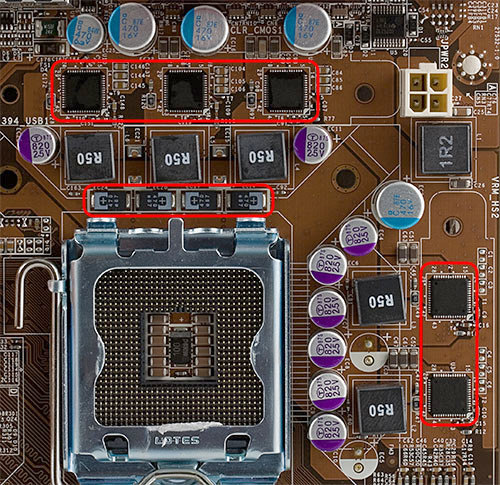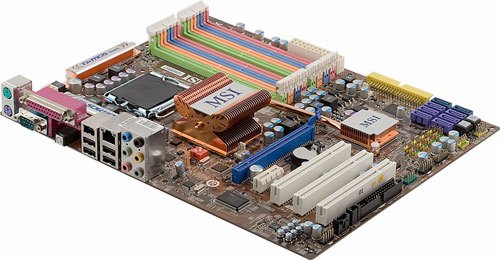MSI presented this motherboard as a demonstration of its engineering skills rather than as a real product with a promising market future. We cannot say that motherboards with six DIMM slots are rare -- this type of solutions often surfaces in transition periods, when the current memory standard is changing. In fact, our present transition process is taking too long, and DDR3 will hardly become wide spread prior to Intel Core i7 processors. In this situation MSI came up with a solution unheard of in the modern history: a motherboard with eight DIMM slots. This move levels up DDR2 and DDR3 memory, it was not made to provide six slots for DDR2 memory, for example. There is certain logic here: combined motherboards used to be limited to two slots for the new memory type; so if you wanted to use advantages of dual-channel memory access, you had to buy two modules, and later on replace them for larger ones to upgrade.
That is even a small group of users interested in a combined motherboard did not face that much problems (all of them solvable). However, other things being equal, if you intended to buy a motherboard for two memory types, MSI P45-8D 'Memory Lover' is definitely worth a look.
Design
This motherboard has a simple PCB layout. Yep, it has eight DIMM slots (besides, they take up much room together with the memory voltage regulator), but no other bells and whistles: no CrossFireX, only five expansion slots, three of them are PCI slots, plus PCIEx1, which may be blocked by a graphics card with a bulky cooler. So it's a good choice for thrifty users, who what to upgrade their computers and keep some of their old components. We have only one question to MSI: why design this motherboard with more expensive Intel P45, if P43 can provide the same functionality, and their only difference (CrossFireX in P45) is not used anyway?
 Marked are four Hi-c CAP capacitors and five DrMOS chips
Marked are four Hi-c CAP capacitors and five DrMOS chips
We were pleasantly surprised by the power supply system. In fact, it's implemented on the level of top solutions: the board uses only polymeric capacitors made in Japan and ferrite chokes. The CPU voltage regulator is the most important component for overclocking, especially for long-term usage. This one is a real attraction of the board: For one, along with polymeric capacitors it uses Hi-c CAP capacitors to minimize heating and guarantee maximum service life in critical conditions.
For two, this motherboard uses DrMOS technology, implemented with Renesas R2J20602 chips, instead of the classic circuits with MOSFETs and drivers in each channel. These chips incorporate both elements (hence the DrMOS name: Driver + MOSFETs). The key advantages of this design: compact layout, higher energy efficiency and switching frequencies. As a result, MSI designed only five channels in the PWM controller, while its competitors have to use circuits with a double-figure number of channels. (This model is not a top product, but the most expensive motherboards from MSI use the same technology now.)

The on-board cooling system is quite simple: a small heatsink on the Southbridge, a copper plate with thin fins on the Northbridge, and tiny copper heatsinks on DrMOS chips, which are used to hold ad-plates rather than to cool the chips (especially considering a very thick layer of thermal grease under them). A heat pipe from Southbridge to the NB heatsink looks more like a serious solution, but it won't make the system more efficient. However, P45 is not a very hot chipset. Its chipset heatsinks grow hot, but their temperature does not cross the critical line, and the small heatsinks on the DrMOS chips remain barely warm.
The board has another two peculiarities -- one's good, the other is not quite. As it goes with top products, this motherboard contains buttons to power on and reset the system, and a clear CMOS button on the rear panel, so you don't have to open a PC enclosure after a failed overclocking attempt. We were disappointed by the switch, responsible for overclocking, which should theoretically set the base FSB frequency. Unfortunately, by default (nominal FSB clock rate) this switch would set the frequency to 400(1600) MHz for both of our test processors (E6600 with FSB of 1066 MHz and E8200 with FSB of 1333 MHz). And BIOS Setup did not allow to reduce the FSB clock below this value, so we had to waste time on search for a working position of the switch.
The board offers ordinary monitoring features (both in BIOS Setup and with Windows utilities), automatic CPU fan speed control is supported. Besides, BIOS Setup provides decent overclocking options, lots of memory timings and voltage tweaks. MSI Memory-Z technology is not streamlined yet, but in most cases it still allows to read SPD data from memory modules right in BIOS Setup.
The bundle does not include extraordinary components either, except for a bracket with eSATA. Just an average bundle. You can read about MSI utilities in our full reviews of motherboards from this company.
Design
This motherboard is based on the Intel P45 chipset (P45 Northbridge and ICH10R Southbridge). You can read about its features in the corresponding review. Besides, the motherboard offers the following extra functions:
- Integrated audio, based on the 10-channel (7.1+2) HDA codec Realtek ALC888 (modern Mid-End codec), 7.1-ch audio, front line-ins/outs (S/PDIF-Out is to be bought separately, as there are no such brackets in the bundle).
- Gigabit Ethernet, based on Realtek RTL8111C (PCIEx1), supporting 10/100/1000 Mbps.
- IDE/SATA-II controller, based on JMicron JMB363 (PCIEx1) supporting two ATA133 devices, including sterling support for CD/DVD drives, and two SATA300 devices, which can form RAID 0 and 1.
- FireWire, based on JMicron JMB381 (PCIEx1) supporting two ports (one of them is installed on the rear panel).
This motherboard supports only processors with VRD 11.1, that is MSI P45-8D cannot be used with processors older than Core 2 Duo. MSI P45-8D does not have any peculiarities as far as both memory types and eight modules are concerned: you can install memory of only one type -- DDR2 (up to 16 GB in total) or DDR3 (up to 8 GB). So the only difference from a common board with four sockets for one memory type is the more complex layout and channel switch circuits. (Unlike solutions that allow to install six memory modules [of one type] in defiance of design guides.) The only issue we should mention here is hardware detection of memory modules and automatic selection of DDR2↔DDR3 voltage levels. So you won't damage DDR3 memory with high voltage and won't have to do much to provide working conditions for DDR2. You may learn more details about motherboard specs and read the list of processors and memory modules tested for compatibility on the official product page (links at the end of the article).
The integrated audio quality was tested in 16 bit 44 kHz mode using RightMark Audio Analyzer 6.0 and the Terratec DMX 6fire sound card. The total score is very good. Note that the IDE controller installed on this motherboard (modern chipsets from Intel lack the integrated solution in their Southbridge) puts up praiseworthy performance. It had absolutely no problems detecting an optical drive at startup and in Windows, allowing to boot from a CD, etc.
Performance
Testbed configurations:
- CPU: Intel Core 2 Duo E8200 (2.66 GHz, 1333MHz FSB)
- Memory:
- 2 x 1 GB Kingston KHX13000D3LLK2/2G (DDR3)
- 2 x 1 GB Corsair CM2X1024-9136C5D (DDR2)
- Graphics card: PowerColor ATI Radeon HD 3870, 512 MB
- HDD: Seagate Barracuda 7200.7 (SATA, 7200 rpm)
- PSU: HiPro W460GC31
- OS: Windows XP SP2
We decided to compare MSI P45-8D with another combined motherboard from MSI we had already reviewed -- X48C Platinum with the X48 chipset.
| Test |
MSI P45-8D (DDR2-800, 4-4-4-2T) |
MSI X48C Platinum (DDR2-800, 4-4-4-2T) |
MSI P45-8D (DDR3-1333, 7-5-5-2T) |
MSI X48C Platinum (DDR3-1333, 7-5-5-1T) |
| Archiving with 7-Zip, min:sec |
3:44 |
3:45 |
3:37 |
3:39 |
| MPEG4 (XviD) encoding, min:sec |
3:04 |
3:03 |
3:03 |
3:03 |
| FarCry (Low@640x480), fps |
470 |
471 |
478 |
475 |
| FarCry (Highest@1600x1200), fps |
183 |
182 |
183 |
182 |
| Doom 3 (Low@640x480), fps |
254 |
251 |
262 |
261 |
| Doom 3 (Highest@1600x1200), fps |
193 |
193 |
196 |
196 |
These test results dictate a conclusion that the "Memory Lover" works well with both memory types -- at least no worse than other combined motherboards. Besides, MSI X48C Platinum performed practically on a par with its single-type competitors (DDR2 versus DDR2 and DDR3 versus DDR3), so you shouldn't worry about performance of MSI P45-8D.
The motherboard provided by the manufacturer,
ATI Radeon HD 3870 graphics card provided by PowerColor.
Write a comment below. No registration needed!


